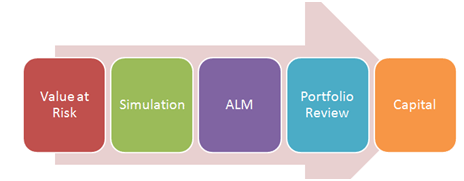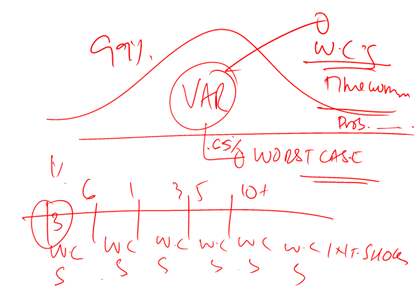ALM Banking models – Assumptions review
In a recent class on Asset Liability Management Models, my MBA students asked a number of interesting questions. The questions were interesting because despite working in Risk Management for two decades I had never been asked these questions prior to this class. Not because my banking audiences knew the answers, but because we had assumed that numbers and models in front of us worked, that someone had done their homework before they presented results to us.
The most likely answer, however, was that we were simply too shy to ask something that we felt would be obvious to everyone else. How could you sit in a senior position in a bank and not know the answer to something as basic and fundamental as the impact of interest rates on banking income and value? The answer is simple. If you don’t use the model on a daily basis, there are too many assumptions to track and remember. There is no shame in getting lost and confused.

While some questions are trivial, others require some insight into ALM modeling. Given the years it took me to get my terminology right, I thought it would be useful to have these ALM related answers around as a guide. Here is a quick list that we will try and answer in this post.
- What is the default convention? Interest rates rising or falling? Income rising or falling?
- What is Asset Sensitivity? What is Liability Sensitivity? Why does it matter?
- What is the difference between Price & Maturity Gap? Between Rate and Reset Gap?
- Common Tweaks and Hacks? Reconciling Income and Value
- ALM in Insurance – How does ALM link to embedded value?
Asset Liability Management Models – What is the default convention? Interest rates rising or falling?
For the purpose of this session (unless stated otherwise) we assume we are working with two Asset Liability Management reports
1) The Net Interest Income at Risk (NII at Risk) report and the Market Value of Equity (MVE) at Risk report. The NII at Risk report tracks changes in income because of a change in interest rates. The MVE at Risk report tracks changes in shareholder value because of changes in interest rates.
2) For both reports, the primary focus is on a positive change in interest rates (rates are rising up). You will see the reason why a little later.
3) If the final result from the NII at Risk report is a positive number it indicates that with interest rates rising, net interest income will fall by the amount indicated by the positive number. If the number is negative, as rates rise, Net Interest Income will also rise by the amount indicated by that number.
4) If the final result from the MVE at Risk report is positive, we expect the value of shareholder equity to fall by that amount, when rates rise. If the number is negative if expect the value of shareholder equity to rise by that amount by rising interest rates.
5) The NII at Risk and MVE at Risk reports generally work with interest rate shocks of 0.25%, 0.5% and 1%. We share or generate results for all three interest rate shocks.

6) When we use a Value at Risk (VaR) based interest rate shock, the NII at Risk report becomes the Earnings at Risk report. When we do the same with MVE at Risk report, it transforms into the Capital or Shareholder Value at Risk Report. We still consider these transformations as static shocks. Certainly more realistic but still weaker than an ALM model linked to simulated, dynamic interest rates.
ALM Modeling – What is Asset sensitivity? Liability sensitivity?
If a bank is Asset Sensitive it means that on its balance sheet assets re-price faster than liabilities. This would mean that as interest rates rise, earning on assets would rise faster than cost (interest expense) of liabilities. As rates would rise, NII would also rise. As rates decline NII would also decline. If Assets re-price faster, the final cumulative NII number would be negative, because there will always be excess liabilities in some buckets and for the sum of all buckets.

If a bank is Liability Sensitive, it means that on its balance sheet liabilities will re-price faster than assets. This would mean as interest rates rise, the cost of financing these liabilities will rise faster than the earnings on assets. As a result, as rates would rise, NII would decline. As rates decline, NII would rise. If liabilities re-price faster the final NII number would be negative because there will always be excess assets in some buckets and for the sum of all buckets.
ALM Modeling – What is the difference between Price & Maturity Gap? Rate and Reset Gap?
Price and Maturity gaps use ALM maturity buckets that are populated on the basis of residual contractual maturity. This means that if I have an asset or an advance with an original maturity of 10 years but remaining maturity of just under 1 year, it will count in the ” up to 1 year ” bucket. Liquidity and MVE at Risk calculations use price and maturity gaps.
Rate and Reset gaps use ALM maturity buckets that populate on the basis of when the next reference interest rate re-pricing will occur. This means that an asset or liability with a remaining maturity of 5 years and a reference rate that resets every 3 months, with the next reset in exactly one quarter away, the loan or advance in question will slot into the 3 month bucket. NII at Risk calculations use rate and reset gaps.
Asset liability management tweaks and hacks
If for target account monitoring you want to compare your NII at risk figure with your annualized net interest income you have to look closely at your ALM output. What would be the impact of a 1% change in interest rates on our NII figures? The NII at Risk reports assumes that you will be able to lock in the new re-priced rate for at least half the length of the maturity bucket in question. For instance, for the six month and 1 year buckets, you will get the benefit of the higher rate for 3 months and 6 months respectively. This assumption may change from one model to the next.
However for larger buckets, especially for target account comparisons, you would most likely need to hack your model. For 3, 5 and 10 year bucket your default ALM model will give you credit for 1.5, 2.5 and 5 years respectively. While your comparative benchmark is one year income. In this scenario, it is advisable to cap the interest rate impact for a maximum value of 1 year. Otherwise, the comparison would be meaningless.
On the other hand, if you are trying to reconcile NII impact with changes in MVE, you will have to use the default setting. Otherwise, the reconciliation logic won’t work.
ALM in Insurance – Embedded value, valuations and ALM
As you can see ALM models work with a number of assumptions and some crude approximation. While logically there should be a link between the results that we get from MVE analysis and any sensitivity testing you do on your valuation and embedded value models, in reality, there will be a large difference.
ALM Models have one primary use. They represent a simplified, crude but quick way of estimating the impact of interest rate changes on income and value. Used consistently they can give boards and risk management an indication of the interest rate mismatch profile of the bank and any significant changes in the same on account of policy, product, concentration, liquidity or investment decisions. They are quick because they use a simple and crude approximation in most cases using static, parallel, interest rate shock.
Nothing that can’t be fixed using a few tweaks and hacks. But if your objective is an accurate answer true to two decimal places in 99% of all scenarios, you are likely to be disappointed.
Liking or linking ALM models to valuation and embedded value models without reconciling the assumptions and results from the two models would only give inconsistent results.
ALM Background Materials
Did the above post cause a case of risk information overload? Remedy it with a quick look at earlier background posts below:

Comments are closed.